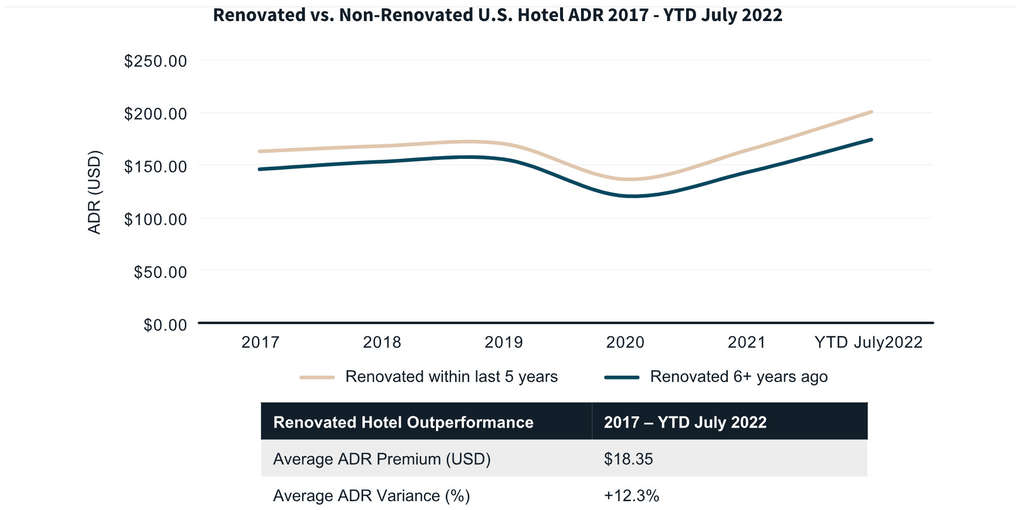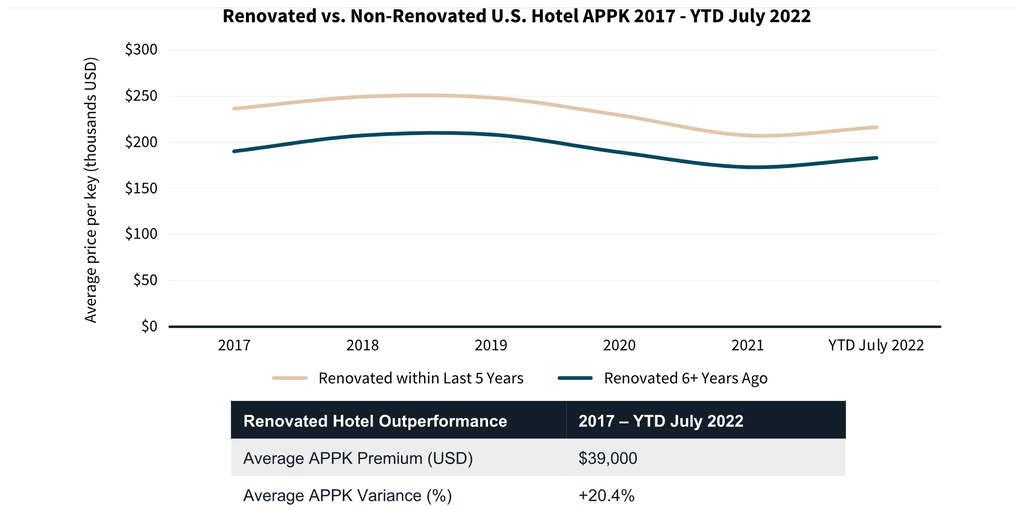Hotel owners turn their attention to renovations
Why tackling deferred maintenance is critical to the lodging industry’s recovery
The hospitality industry continues to rebound from the decline in travel during the COVID-19 pandemic. Yet, one lingering impact looms. With maintenance and renovation projects mostly deferred over the last two-and-a-half years, guest satisfaction is taking a hit from outdated and inconsistent hotel conditions. The latest J.D. Power North America Hotel Guest Satisfaction Index shows that overall guest satisfaction is down 8 points on a 1,000-point scale, driven in part by dissatisfaction with guest rooms.
Prior to 2020, the average hotel was renovated every 7 to 10 years. While the extent of these renovations has always varied by hotel type, size and location, hoteliers typically replaced soft goods like bedspreads carpet and upholstery furnishings every 5 to 7 years, with full-scale renovations including case goods & bathrooms happening at 11 to 14-year intervals.
Then COVID-19 took hold, causing revenues to plummet in the face of extremely limited demand. During the height of the pandemic, revenue per available room (RevPAR) declined more than during 9/11 and the Great Financial Crisis combined. Many hotel owners had to dip into their furniture, fixtures and equipment (FF&E) reserves just to make payroll, cover debt service and avoid potential foreclosure. With an uncertain timeline for recovery, and most owners singularly focused on returning to profitability, maintenance and renovation has been largely ignored by many hotel owners, while those few with strong financials took advantage of the downturn and lack of displacement to renovate.
Now, RevPAR in US hotels is fully recovered and it’s time for owners to prioritize capital expenditures and renovation. Evidence shows renovated hotels benefit from elevated operating performance—but navigating today’s challenging construction environment requires diligence and experience.The business case for regular hotel renovations
In many instances, hotel owners can’t ignore the mandate to renovate. Property improvement plans (PIPs) are required across nearly all hotel brands to ensure standardization and consistency. While brands have been lenient with struggling hotels over the last two years, some are starting to be more aggressive in enforcing PIP compliance, but may adjust depending on the direction of the economy.
Property reinvestment and renovation also offer clear monetary benefits. Renovated hotels consistently generate RevPAR premiums relative to competitors—often via elevated average daily rates (ADR), which can result in higher profits. Additionally, renovated hotels usually sell for a higher average price per key (APPK). The charts below visualize the financial benefits of regular renovations.
Overcoming renovation challenges
With so many areas of hotels requiring repairs and updates, it can be difficult to know where to begin. While the needs of each hotel vary, several industry trends are driving investment needs today.
For example, COVID-19 brought a heightened focus on guest health and safety. Meanwhile, eco-conscious travelers are drawing more attention to sustainability issues. These two trends are driving investments in property infrastructure.
Many hotels are also seeing a need to renovate guestrooms, which generally bear higher wear and tear, and require frequent updates to keep pace with shifting trends. Given the spiraling deferred maintenance of the past two years, many guestrooms require replacement of both soft goods and case goods (e.g., furniture), as well as complete bathroom remodels, and technology and systems upgrades. Others are looking at targeted public area projects with direct positive returns on investment.
All of these types of investments are becoming more critical as the industry recovers and guest expectations rise in tandem with growing hotel rates. Yet despite the obvious advantages of renovation and reinvestment, many owners have been hesitant to move forward—and for understandable reasons. Full-scale renovations will last two to three years and are often intrusive and disruptive, leading to a short-term decline in revenues.
Meanwhile, inflation, shipping issues and long lead times are escalating project costs and complicating schedules, as highlighted in JLL’s H2 2022 Construction Outlook. Although the challenges may seem daunting, there are several reasons why hotels should move forward with renovations now, rather than wait out these headwinds:
- Many medium-scale trades and general contractors are filling up their backlogs to keep quality talent on their payrolls, so they are ready to discount their fee markups and general conditions—a trend that will dissipate as economic conditions improve.
- The housing and automotive industry slowdowns have stalled price increases for select materials, but that could reverse should interest rates fall and when projects funded by the Infrastructure Investment and Jobs Act ramp up.
- Material prices are expected to remain high as steel and lumber companies are cutting production to prop up pricing at current levels, while elevated construction activity will continue to generate solid demand.
- Attempting to wait out lead-time issues simply compounds delays; it is better to tackle them today.
By incorporating experienced project managers early in the design process and thoroughly vetting subcontractor capacity, hotels will be better equipped to navigate complex renovations while minimizing business impact.
Revitalizing hotels for a prosperous future
Given the delicate and long-awaited recovery of many hotels, investing in renovations and updates is a complicated but necessary step to ensure future profitability. JLL’s Project & Development Services team is uniquely positioned to assist and guide owners through this process. With a research-based approach, our experienced project managers help to mitigate potential issues and minimize business disruptions.
About JLL
For over 200 years, JLL (NYSE: JLL), a leading global commercial real estate and investment management company, has helped clients buy, build, occupy, manage and invest in a variety of commercial, industrial, hotel, residential and retail properties. A Fortune 500® company with annual revenue of $20.8 billion and operations in over 80 countries around the world, our more than 111,000 employees bring the power of a global platform combined with local expertise. Driven by our purpose to shape the future of real estate for a better world, we help our clients, people and communities SEE A BRIGHTER WAYSM. JLL is the brand name, and a registered trademark, of Jones Lang LaSalle Incorporated. For further information, visit jll.com.






